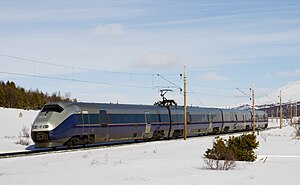| NSB Class 73 | |
|---|---|
 Class 73 on the Dovre Line | |
| In service | 1999–present |
| Manufacturer | Adtranz, Strømmen, ABB |
| Number built |
|
| Capacity |
|
| Operators | |
| Lines served |
|
| Specifications | |
| Train length | 108.48 m (355 ft 11 in) (four cars) |
| Maximum speed | 210 km/h (130 mph) |
| Weight | 215 t (212 long tons; 237 short tons) |
| Power output | 2,646 kW (3,548 hp) |
| Electric system(s) | 15 kV 16.7 Hz AC overhead catenary |
| Current collector(s) | Pantograph |
| Track gauge | 1,435 mm (4 ft 8+1⁄2 in) standard gauge |
NSB Class 73 (Norwegian: NSB-type 73) is a class of 22 electric multiple units built by Adtranz for the Norwegian State Railways. The four-car trains were modifications of Class 71, which was again based on the Swedish X2. The A-series consists of 16 intercity trains; they were delivered in 1999 and 2000 and are used on the Bergen, Dovre and Sørland Lines. The intercity service was branded as Signatur until 2003. The B-series consists of six regional trains delivered in 2002 and used on the Østfold Line. The regional trains were originally part of the Agenda concept. The trains have a power output of 2,646 kilowatts (3,548 hp) and a maximum speed of 210 km/h (130 mph). They have an overall length of 108 meters (354 ft) and have a capacity for 208 seated passengers in the A-series and 250 in the B-series. The trains have a tilting mechanism allowing for faster travel through curves.
The trains were delivered late, and were put into service after the Norwegian Railway Inspectorate had given dispensation from parts of the safety regulation. On 17 June 2000, a train derailed at Nelaug Station after an axle broke. The class was grounded for a month, and the investigation showed both design errors, and lack of proper inspection and testing. After they were put back into service, they were not allowed to use the tilting mechanism—thus not being allowed to run faster than their predecessors. The construction was reinforced, and in 2004, the tilting mechanism was re-enabled along with higher speeds. In 2007, a train derailed on the Bergen Line, and questions were raised about the trains' ability to operate in snow, however the accident report showed that the trains' front axle load was just as able to cope with heavy snow conditions as the locomotives running on the line, and that the derailment would have been more severe if the same conditions would hit a normal train with less secure connections between carriages. On 16 June 2011, two units were destroyed when the train ran into a fire in a snow tunnel at Hallingskeid Station.